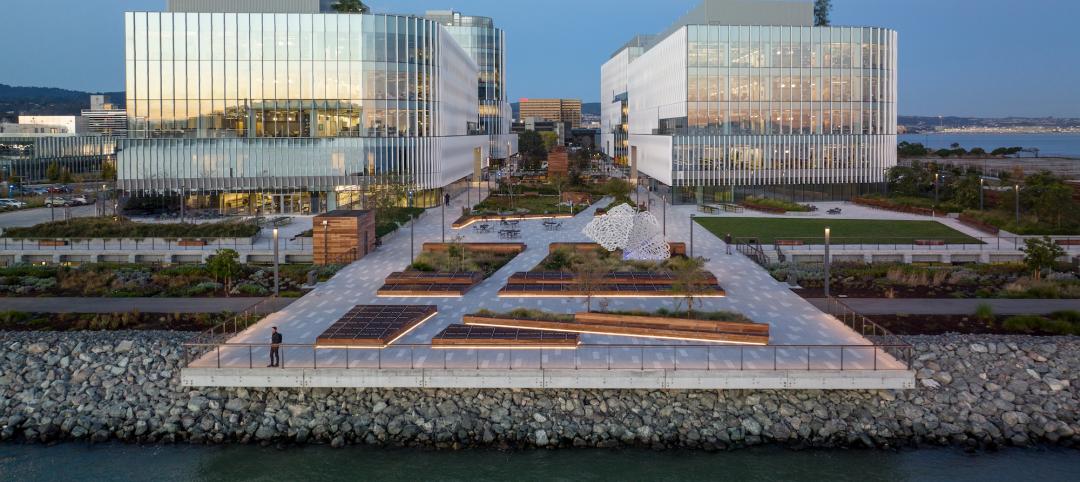A new research report explores the past, present, and future of the workplace and reveals how organizations are using new strategies to improve the productivity and success of employees.
The International Facility Management Association (IFMA) released Distributed Work Revisited: Research Report #37, which is a follow-up to its 2009 Distributed Work report. Workplace strategy and design experts HOK helped IFMA develop and analyze the survey, collect the case studies and write the report.
IFMA members from 538 different organizations worldwide—83% were from the U.S. and Canada—completed an online questionnaire about their on- and off-site workplace accommodations, operational needs, technologies, specific facilities, change management processes and measurements for success. The area occupied by participating organizations ranges from 50,000 to more than 1 million sf. Distributed Work Revisited summarizes the complete survey results and provides a detailed analysis of the findings.
The report features case studies describing innovative distributed work programs across different stages of maturity in eight organizations: Microsoft, GSK, eBay, Credit Suisse, the U.S. General Services Administration, Accenture, Rockwell Collins and the City of Calgary. Results of the study reveal some surprising details about today’s workplace. Highlights include:
• Distributed work is still a relatively new concept. Sixty-one percent of facility professionals responding to this survey reported using unassigned workspaces in their facilities. Only 18% of survey participants have had a distributed work program in place for more than 10 years and 37% for more than five years.
• One hundred percent of survey respondents who reported implementing unassigned on-site distributed work options cited work-life balance as being a “very important” reason for doing so. Other factors listed as “very important” were to accommodate changes in the organization’s size (64%), leverage new technology (62%), increased productivity (60%), align with organizational goals (59%), cost savings (57%), improved flexibility (56%) and benefits for employees (55%).
• Employee benefits are the major drivers for off-premise solutions, enabling organizations to improve flexibility and support work-life balance.
• Respondents reported that distributed work strategies appeal most to Generation X (aged 35-48) employees, possibly because they work more independently than other groups and are more likely to have family commitments that require flexibility in how and where they work.
• The most popular on-site distributed work settings among respondents are spaces that promote collaboration and innovation, including war/project rooms (72%), huddle rooms (70%) and open lounge/soft seating areas (67%).
• More organizations are providing incentives to employees adopting distributed work. Thirty-three percent of respondents reported that when they adopted a distributed work policy, they provided an incentive—typically technology such as a laptop or mobile device—to employees. This is up from 18% in 2009.
• More organizations are measuring the results of their distributed work programs. Almost one-third of the organizations engage their workforces in testing and carrying out distributed work settings. This is up from 19% in 2009.
• Despite the expressed importance of employee engagement and satisfaction in achieving successful distributed work programs stated in the interviews, only 45% of the respondents mentioned use of change management processes.
The complete version of Distributed Work Revisited: Research Report #37 is available for sale on IFMA’s website. Funds raised support ongoing and future research.
Related Stories
High-rise Construction | Dec 7, 2022
SOM reveals its design for Singapore’s tallest skyscraper
Skidmore, Owings & Merrill (SOM) has revealed its design for 8 Shenton Way—a mixed-use tower that will stand 63 stories and 305 meters (1,000 feet) high, becoming Singapore’s tallest skyscraper. The design team also plans to make the building one of Asia’s most sustainable skyscrapers. The tower incorporates post-pandemic design features.
Office Buildings | Dec 7, 2022
Software giant SAP opens engineering academy for its global engineering workforce
Software giant SAP has opened its new SAP Academy for Engineering on the company’s San Ramon, Calif. campus. Designed by HGA, the Engineering Academy will provide professional development opportunities for SAP’s global engineering workforce. At the Engineering Academy, cohorts from SAP offices across the globe will come together for intensive, six-month training programs.
Office Buildings | Dec 6, 2022
‘Chicago’s healthiest office tower’ achieves LEED Gold, WELL Platinum, and WiredScore Platinum
Goettsch Partners (GP) recently completed 320 South Canal, billed as “Chicago’s healthiest office tower,” according to the architecture firm. Located across the street from Chicago Union Station and close to major expressways, the 51-story tower totals 1,740,000 sf. It includes a conference center, fitness center, restaurant, to-go market, branch bank, and a cocktail lounge in an adjacent structure, as well as parking for 324 cars/electric vehicles and 114 bicycles.
Mixed-Use | Dec 6, 2022
Houston developer plans to convert Kevin Roche-designed ConocoPhillips HQ to mixed-use destination
Houston-based Midway, a real estate investment, development, and management firm, plans to redevelop the former ConocoPhillips corporate headquarters site into a mixed-use destination called Watermark District at Woodcreek.
Office Buildings | Dec 5, 2022
How to foster collaboration and inspiration for a workplace culture that does not exist (yet)
A building might not be able to “hack” innovation, but it can create the right conditions to foster connection and innovation, write GBBN's Chad Burke and Zachary Zettler.
Giants 400 | Dec 1, 2022
Top 100 Office Building Core+Shell Contractors and CM Firms for 2022
Turner Construction, AECOM, Clayco, and Gilbane top the ranking of the nation's largest office building core+shell contractors and construction management (CM) firms for 2022, as reported in Building Design+Construction's 2022 Giants 400 Report.
Giants 400 | Dec 1, 2022
Top 75 Office Building Core+Shell Engineering + EA Firms for 2022
Jacobs, Alfa Tech, Burns & McDonnell, and Arup head the ranking of the nation's largest office building core+shell engineering and engineering/architecture (EA) firms for 2022, as reported in Building Design+Construction's 2022 Giants 400 Report.
Giants 400 | Dec 1, 2022
Top 150 Office Building Core+Shell Architecture + AE Firms for 2022
Gensler, NBBJ, Perkins and Will, and Stantec top the ranking of the nation's largest office building core+shell architecture and architecture/engineering (AE) firms for 2022, as reported in Building Design+Construction's 2022 Giants 400 Report.
Multifamily Housing | Nov 29, 2022
Number of office-to-apartment conversion projects has jumped since start of pandemic
As remote work rose and demand for office space declined since the start of the Covid-19 pandemic, developers have found converting some offices to residential use to be an attractive option. Apartment conversions rose 25% in the two years since the start of the pandemic, with 28,000 new units converted from other property types, according to a report from RentCafe.
Giants 400 | Nov 28, 2022
Top 130 Office Sector Contractors and CM Firms for 2022
Turner Construction, STO Building Group, Gilbane, and CBRE top the ranking of the nation's largest office sector contractors and construction management (CM) firms for 2022, as reported in Building Design+Construction's 2022 Giants 400 Report.

















